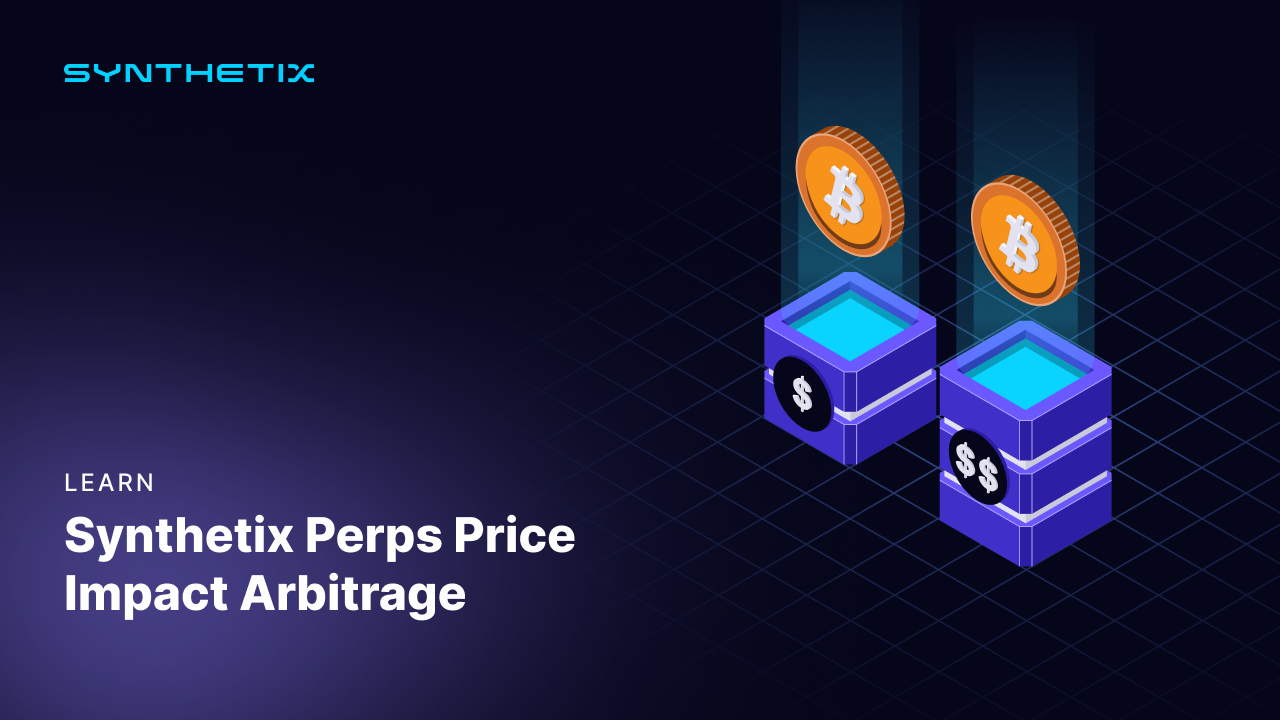Synthetix Perps Price Impact Arbitrage
Following our prior post on funding rate arbitrage in Synthetix Perps, the next potential strategy presents itself: Price Impact Arbitrage. This approach focuses on capitalizing the premium or discount introduced by the price impact function.

Introduction
Following our prior post on funding rate arbitrage in Synthetix Perps, the next potential strategy presents itself: Price Impact Arbitrage. This approach focuses on capitalizing the premium or discount introduced by the price impact function within Synthetix Perps markets during temporary market imbalance.
Understanding Price Impact in Synthetix Perps
As explained in our previous posts, Synthetix Perps has crafted an engine where liquidity providers' delta neutrality is maintained through mechanisms like Dynamic Funding Rates & the Price Impact function. The price impact function adjusts the execution price of trades based on market skew and trade size, creating opportunities for arbitrage against the external market price (aka the oracle price) when the market leans in one direction.
Delta Neutrality and Market Balance
A core goal of the Synthetix Perps system is to maintain delta neutrality, where the market is balanced, and no single side (long or short) persistently dominates. This balance is critical for the market's performance and liquidity providers' financial health. When the market is long or short-skewed, the Price Impact function generates a premium (or discount) for taking the less skewed side, thus incentivizing traders to bring the market back to equilibrium.
The Price Impact Function at Work
Imagine the ETH perp market has a long skew on ETH (meaning it has more longs than shorts). A trader identifying this could enter a short position, receiving a premium on their execution price due to the existing skew. This means that a trader is able to short ETH at a higher than Oracle price value. The degree of impact on the price depends on the initial and final skew before and after the trade. This dynamic ensures that traders are encouraged to take positions that lead to a balanced market.
The Arbitrage Strategy: Exploiting Price Deviations
Arbitrageurs can exploit the price discrepancies caused by market imbalances.
For instance, if Synthetix Perps is showing a significant long skew on ETH and another platform has a more balanced skew, there lies an opportunity:
- Short on Synthetix Perps: Enter a short position on ETH at a premium price due to the long skew.
- Long on Another Platform: Simultaneously, take a long position on ETH on a different platform where the price is closer to the oracle price.
- Market Rebalance: As other traders notice the imbalance on Synthetix, they, too, may take short positions, correcting the skew.
- Exit and Profit: The arbitrageur can then close both positions once the discrepancy between Synthetix Perps and the other platform's prices diminishes or reverses, ideally at a profit.
An Example Calculation:
Trade Parameters:
- Arbitrage Trade Size: $10,000
- Premium on Synthetix Perps due to Long Skew: 0.5%
- Price on Synthetix Perps: ETH at a 0.5% premium
- Price on Another Platform: ETH at the Oracle price
Transaction Costs:
- Synthetix Perps Fees: Maker fee 0.02% (2bps), Taker fee 0.06% (6bps)
- Another Platform Fees: Flat fee 0.07% (7bps)
Trade Execution:
- Opening the Trade:
- The trader shorts ETH on Synthetix Perps for $10,050 (due to the 0.5% premium).
- Simultaneously, the trader takes a long position on another platform for $10,000.
- Synthetix Perps Opening Fee as Taker: $10,050 x 0.0006 = $6.03
- Alternate Platform Opening Fee: $10,000 x 0.0007 = $7
- Closing the Trade:
- The market skew is corrected, and the trader closes both positions at the Oracle price.
- Synthetix Perps Closing Fee as Taker: $10,000 x 0.0006 = $6
- Alternate Platform Closing Fee: $10,000 x 0.0007 = $7
Total Fees for the Round-Trip Trade:
- Synthetix Perps Fees: $6.03 (opening) + $6 (closing) = $12.03
- Alternate Platform Fees: $7 (opening) + $7 (closing) = $14
Total Transaction Costs:
- Combined Fees: $12.03 (Synthetix Perps) + $14 (Alternate) = $26.03
Profit Calculation:
- Gross Profit: The trader entered the short position at a $50 premium ($10,050) and closed at the Oracle price ($10,000), realizing a gross profit of $50.
- Net Profit: $50 (gross profit) - $22.03 (total fees) = $23.97
Conclusion:
After accounting for the fees on both platforms, the net profit from this arbitrage trade would be $27.97. This calculation assumes that all trades were executed at the desired prices without any additional slippage or changes in market conditions during the trade's execution. Traders must account for all potential costs and risks when evaluating the profitability of arbitrage opportunities.
Risks and Considerations
This arbitrage strategy isn't without its challenges and risks, here are some potential risks and considerations:
- Liquidity and Slippage: Liquidity on both platforms must be sufficient to enter and exit positions without causing significant slippage.
- Transaction & Trading: Factor in trading fees & transaction fees to better understand the potential profitability of an arbitrage trade.
- Market Volatility: Sudden market moves can change the skew on both markets to different extents, leading to potential losses.
Questions or Comments?
If you have any questions or comments, please visit the Synthetix Discord.

